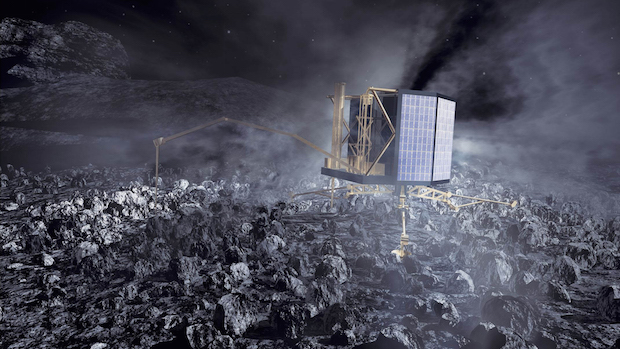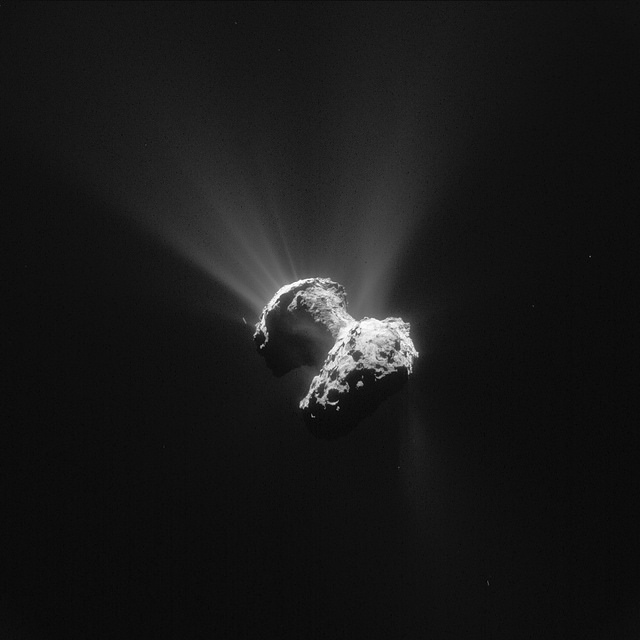
Europe’s Rosetta comet probe re-established momentary contact with the Philae lander late Thursday, renewing hopes of starting up the craft’s research instruments after two weeks of radio silence dampened the moods of scientists.
Thursday’s contact, which lasted 12 minutes before failing, was the first time ground controllers heard from Philae since 24 June, continuing a puzzling on-and-off radio connection with the lander since it awoke from hibernation and broadcast a message to Earth on 13 June.
The messages received from Philae in mid-June buoyed the mood of the lander’s science team, which had not radioed home since it drained its batteries two days after its 12 November 2014 landing on the comet.
Engineers can only communicate with the three-legged lander through its Rosetta mothership, which is flying around comet 67P/Churyumov-Gerasimenko as it heads for perihelion – the closest point in its orbit to the sun – on 13 August.
Solar heating is activating the comet’s jets, spewing columns of dust and vapours for dozens of miles from the nucleus. The debris cloud has kept Rosetta from approaching too close to the comet, complicating efforts to establish a stable connection with Philae.
Engineers at the Philae control center in Cologne, Germany, sent an initial test command Sunday to activate a transponder on the lander. The transponder, part of Rosetta and Philae’s CONSERT radio science experiment, operates in a different frequency band than Philae’s S-band radio used to downlink telemetry data.
Scientists designed CONSERT to help analyze the comet’s internal structure by measuring radio waves as they pass through the nucleus, yielding insights about what is inside comet 67P.
Controllers opted to activate CONSERT in hopes of getting a ping from Philae’s transponder to confirm the lander was still alive. A second command to turn on the CONSERT transponder was sent Thursday, and it was successful, according to a status update released by the German space agency, DLR, which runs Philae’s control centre.
Thursday’s connection came through the lander’s S-band radio system used for regular communications.
“We got lots of new information – lots of data – and we confirm that the CONSERT unit was switched on, and new information is hopefully going to help us try to understand why we’re having these difficulties in communicating with Philae,” said Koen Geurts, an engineer at the lander control center in Cologne, in an update posted online by DLR.
Geurts said it is encouraging to hear from Philae – and to confirm the lander is receiving and appropriately responding to commands – despite the trouble establishing regular contact. DLR officials said the long silence since 24 June caused engineers to wonder if Philae was still alive.
Rosetta, Philae and comet 67P are traveling about 300 million kilometres (186 million miles) from Earth.
The latest data show Philae’s internal temperature is hovering near zero degrees Celsius, giving hope that the lander can charge its batteries and start scientific observations. But first, controllers have to solve the communications problem.
Philae’s anchoring system failed to deploy when it touched down on the comet in November, and the probe bounced across the nucleus until settling against a cliff, which blocked sunlight from reaching the lander’s body-mounted power-generating solar panels.
Now that comet 67P is closer to the sun, Philae is getting enough sunlight to produce enough electricity to power up its radio and some of its science instruments.

Rosetta has spent the last few months conducting long-range observations of comet 67P from a distance of more than 200 kilometers, or about 120 miles. Rosetta’s control team backed the orbiter away from the nucleus after dust particles jammed the craft’s navigation system in late March.
Engineers based at Rosetta’s control centre in Darmstadt, Germany, are cautiously driving the spacecraft closer to the comet.
“The overall plan, at the moment, is to try to get Rosetta as close as possible to the comet nucleus (for perihelion),” said Matt Taylor, Rosetta’s project scientist at the European Space Agency.
“The star trackers are finding it difficult to navigate – pick out stars – when we are close to the nucleus,” Taylor told Spaceflight Now on Monday.
Rosetta carries cameras to identify bright stars, feeding its computer data on which way the spacecraft is pointing. The craft’s orientation is critical to keep its antenna pointed toward Earth and its cameras aimed at the comet.
“This means we are skirting a safe distance from the comet, (but) as close as possible,” Taylor said. “We analyze each orbit leg, and if things look OK, we step down by 5 or 20 kilometres (3 or 12 miles). Once we start to get too much noise on the star trackers, and lose too many stars, that means we are at the edge of risk and won’t step down any more.”
Taylor said Rosetta’s orbit has been optimized to communicate with Philae in recent weeks. It is a balancing act to share time between Rosetta’s own science – the primary objective of the 1.4 billion euro (US$1.6 billion) mission – and devoting resources to troubleshooting communications disruptions with Philae.
“Soon, we must start moving to other latitudes, in particular to get a better view of the [comet’s] southern hemisphere, which has just come into sunlight,” Taylor said.
Email the author.
Follow Stephen Clark on Twitter: @StephenClark1.



